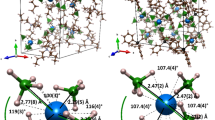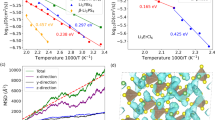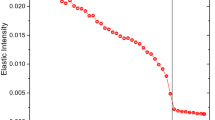Abstract
IN a recent communication in Nature, Dr. C. J. H. Schutte1 has suggested that the anomalous band occurring at about 1,250 cm.−1 in the paraffin-oil mull spectrum of lithium borohydride at room temperature2 may be assigned to the doubly degenerate frequency, ν̄2(E), of tne tetrahedral ion. This frequency is normally inactive in the infra-red, but it is suggested that under the space-group V h of crystalline, orthorhombic lithium borohydride, the ions occupy sites of symmetry C s; the degeneracy is thereby removed so that all the fundamentals are now allowed.
This is a preview of subscription content, access via your institution
Access options
Subscribe to this journal
Receive 51 print issues and online access
$199.00 per year
only $3.90 per issue
Buy this article
- Purchase on SpringerLink
- Instant access to full article PDF
Prices may be subject to local taxes which are calculated during checkout
Similar content being viewed by others
References
Schutte, C. J. H., Nature, 189, 745 (1961).
Price, W. C., J. Chem. Phys., 17, 1044 (1949).
Brown, D. A., J. Chem. Phys., 29, 451 (1958).
Longuet-Higgins, H. C., and Brown, D. A., J. Inorg. and Nuclear Chem., 1, 60 (1955).
Ford, P. T., and Richards, R. E., Discuss. Farad. Soc., 19, 230 (1955).
Taylor, R. C., Schultz, D. R., and Emery, A. R., J. Amer. Chem. Soc., 80, 27 (1958).
Author information
Authors and Affiliations
Rights and permissions
About this article
Cite this article
BROWN, D. The Borohydride Ion in the Lithium Borohydride Lattice. Nature 190, 804 (1961). https://doi.org/10.1038/190804b0
Issue date:
DOI: https://doi.org/10.1038/190804b0



